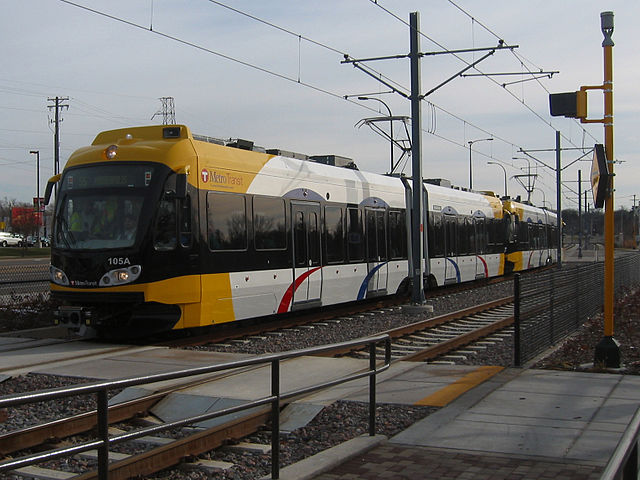
Matt Doll, Minnesota Environmental Partnership
Last week, Hennepin County and the Metropolitan Council announced their new preferred route for the Blue Line light rail extension, a major transit project that would connect communities in North Minneapolis, Crystal, Robbinsdale, and Brooklyn Park with the existing Blue Line. This particular route is a significant victory for some of the state’s most diverse communities, who rely on public transit to get to work and run errands, and would greatly benefit from Blue Line access. A previous route would have skipped North Minneapolis, while the new map would run along Broadway Avenue through the heart of the community.
The Blue Line currently connects downtown and south Minneapolis with MSP airport and the Mall of America, and links with the Green Line between Minneapolis and St. Paul. Together, the lines had a ridership of over 10 million in 2021 – a number that has been depressed by COVID-19 but has increased steadily since 2020. These lines have an added benefit of connecting to numerous bus lines, including Bus Rapid Transit routes.
When constructed, the project would link thousands of Minnesotans along this network with frequent, affordable and more reliable service. By giving Minnesotans a non-car option to get around, it will help remove cars from the road and reduce greenhouse gas emissions. This can help reduce air pollution and protect the health of communities disproportionately affected by that pollution, as well as reduce deaths from auto collisions, which were at their highest level since 2007 last year.
This extension has been long awaited. Initial planning began more than twelve years ago, and has faced hurdles that have lengthened the wait, especially the dispute about using land owned by the BNSF railway. Meanwhile, the Green Line extension that will run from downtown Minneapolis through its southwestern suburbs to Eden Prairie, is far closer to completion, though it is contending with cost overruns and other issues.
As MEP wrote last year, the wait on the Blue Line extension is emblematic of the transportation disparities that fall along the same lines as so many other disparities in Minnesota. The largest of the corridor’s communities – Brooklyn Park and North Minneapolis – have high concentrations of people of color, and they host or are adjacent to highly-traveled segments of I-94 and industrial sites. Not coincidentally, Minnesota’s communities of color are highly at risk of air pollution above health guidelines. Extensions for the Green Line and the Blue Line are both excellent steps for Minnesota’s climate, health and quality of life, but it is troubling that the extension that would most benefit diverse communities economically, environmentally and from a public health perspective is progressing so much more slowly than the line proceeding through largely white and affluent suburbs.
Encouragingly, Metro Transit has explicitly pledged to include environmental justice in its planning and analysis. This includes anti-displacement work to help prevent community members’ lives and livelihoods from being upended by development. The agency has also made its environmental analysis available and developed plans to minimize the impact of construction and operation of the rail line.
With generally strong local support, the main challenge now facing the extension is clearing funding hurdles. Some in the legislature have expressed opposition to funding light rail given the significant construction costs. But given the increasingly urgent need – and widespread support – for Minnesota to reduce our largest sources of carbon emissions and reduce our dependence on fossil fuels, the case for the Blue Line extension is stronger than ever. It runs on electricity, generates no air pollution at the train, and helps connect people and jobs safely and quickly.
As project leaders and elected officials have said, the Blue Line extension is about justice – about reinvesting in communities that have been historically neglected in our state. We at MEP hope to see this project continue to move forward and will work with our partners to build support for this important investment in public transit.
MetroTransit is accepting comments on the Blue Line extension route online and at meetings through May 18.
For previous columns, visit mepartnership.org/category/blog/. If you would like to reblog or republish this column, you may do so for free – simply contact the author at matthew@mepartnership.org.